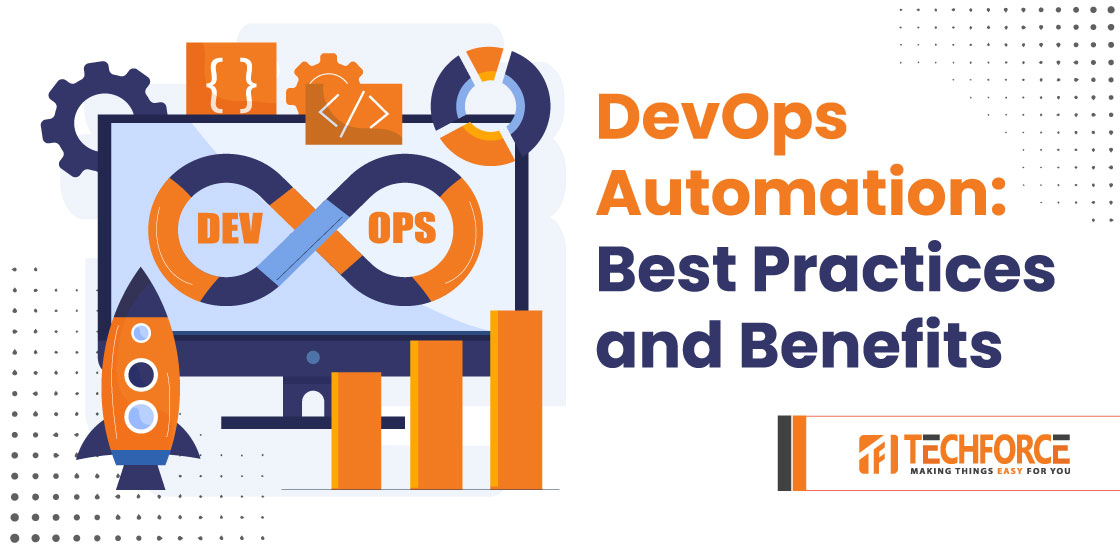DevOps Automation Best Practices & Benefits
DevOps automation is the use of technology to streamline the software development and operations process. It enables organizations to build rapidly and reliably, test, deploy, and manage applications. By automating various tasks, DevOps helps to increase efficiency, reduce errors, and speed up delivery times. The best practices for DevOps automation include continuous integration, continuous delivery, infrastructure as code, and monitoring and logging. The benefits of DevOps automation are numerous, including improved collaboration between development and operations teams, faster time-to-market, reduced downtime, and increased efficiency and scalability.
DevOps
The terms “development” and “operations” are combined to form the term “DevOps,” which, however, refers to a considerably broader set of concepts and methods than either term alone or jointly. Automation is the use of technology to complete tasks with less assistance from humans. Automation can be used in any industry with repetitive operations.
The goal of DevOps is to shorten and optimize the software development lifecycle and support integration, continuous delivery, and continuous deployment (CI/CD) workflows and speed up operations.
DevOps Automation
- DevOps automation is the process of automating manual & repetitive tasks with less involvement of humans. The main objective of DevOps automation is to reduce the workload for developers and IT operations. DevOps automation can help developers create programs more rapidly and efficiently. Also, it smoothens the process, reduces the team size, decreases human error significantly, increases productivity, and saves time.
- There are various practices, processes, and techniques involved, and they can vary as per the organization’s requirements, but the truth is you must prioritize the tasks and also have to choose and pick the job when building the automation. Software tools like Docker, Kubernetes, Jenkins, etc are used by DevOps to optimize each step of efficient software development.
Best practices for DevOps Automation
- While building any automation the objective needs to satisfy customers, regardless of which strategy you choose. As of now, the customer has high expectations for frequent upgrades and quick delivery of new functionalities. You can accelerate the release process with DevOps automation. The same individuals add new functionalities, and the releases make it simpler to deliver to the end users more quickly.
- Practically, It is not possible to automate every process in DevOps Pipeline. Also, it cannot remove human efforts completely. Somehow human intervention is required in handling situations when something goes wrong in the Process or needs any modification/alteration. So, automate every possible process in the pipeline to reduce the dependencies.
- While building automation use the right tools based on requirements whether it’s related to CI/CD, monitor different metrics, and notify when things go wrong.
Benefits
- Scalability: Scaling automated processes is significantly simpler than manual processes. It can be configured while building the automation process. Via manual process, it will take more time compared to automated. However, scaling in an automated environment is only limited by the availability of the underlying software and hardware, which is not a problem in cloud-based systems as resources are scaled automatically in response to workload/traffic.
- Consistency: Automation is particularly useful for finding bugs and problematic behaviors in software or applications. Any highly automated process or operation has a consistent and foreseeable outcome. You’ve eliminated user errors because of the underlying static program configuration and the absence of human interaction.
- Flexibility: We can be flexible with automation in terms of the process’s scope and functionality. Most of the time, the configuration of the automated process—which can be quickly altered to fit the needs—is the only restriction on functionality and scope. Compared to teaching a team member to adjust to processing changes, it is more adaptable.
- Speed: The capacity to go through the lifecycle stages quickly has a substantial impact on the project’s deliverability, making it one of the most crucial aspects of DevOps. We can complete each step without any delays because an automated process will be carried out independent of the time or availability of team members to manually initiate the operation. Additionally, compared to manually performing a procedure, automating it with a standard template almost always results in faster performance.
In conclusion, DevOps automation is a critical component of modern software development and operations. By adopting best practices such as continuous integration and delivery, infrastructure as code, and monitoring and logging, organizations can improve collaboration, speed up delivery times, reduce errors, and increase efficiency.
The benefits of DevOps automation are numerous and include improved agility, increased reliability, and reduced downtime. Implementing DevOps automation can help organizations to stay ahead of the competition and meet the rapidly changing demands of the market. Therefore, organizations that want to stay ahead in the digital race should consider implementing DevOps automation as part of their overall strategy.
 Abhilash Kabira
6 Feb 2023
Abhilash Kabira
6 Feb 2023
 US +1 (630) 296 6606
US +1 (630) 296 6606
 India +91 (79) 48904529
India +91 (79) 48904529
 Poland +48 (730) 059 665
Poland +48 (730) 059 665
 reach@techforceglobal.com
reach@techforceglobal.com
 +1 630 303 7389
+1 630 303 7389

 Calendly
Calendly
 LinkedIn
LinkedIn
 Whatsapp
Whatsapp
 Fintech
Fintech
 Education
Education
 Ecommerce
Ecommerce
 Healthcare
Healthcare
 Travel and Hospitality
Travel and Hospitality
 Public Sector
Public Sector




